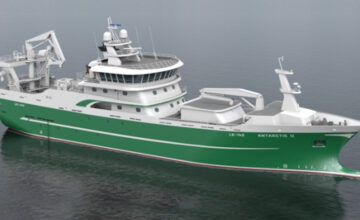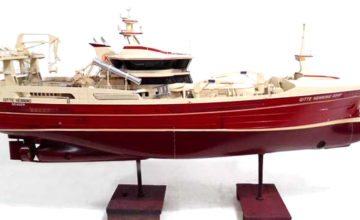Shipbuilding in Vizcaya in the nineteenth and twentieth century
- Dec 13, 2012
- By admin
- In Bilbao Port, Ship Building
- 0 Comments
By Jesús M ª Valdaliso
The transition from sail to steam vessels and the crisis of traditional shipyards
The wooden shipbuilding industry which had a tradition for centuries in Vizcaya, after a depressing situation in the first three decades of the nineteenth century, enjoyed its last boom in the 1840s and 1850s, due to the trade revival and the maritime transport on one hand and the protection duty by the State on the other. The Basque Provinces were integrated to the Spanish Crown customs system.
Madoz states in the Historical Statistics dictionary of Spain that shipbuilding was in 1850 the second economic sector just behind the ironworks factories.
This industry experienced a decline from the 1870s, until it almost disappeared in the mid-1880s. The root cause of this decline was the opening of the market to foreign competition, technological change that took place in the maritime sector, replacing the wooden sailing ships of iron hull (and then steel) steam powered and the inability of Biscay shipyards to adapt to new patterns of demand in the market.
Start and development of the first modern shipyard (1889-1936)
The first attempt to establish an iron and steel shipbuilding industry in Vizcaya was not reality until the late nineteenth century. It was closely linked to the demand by the government.
Nervión Shipyards, Inc., was the company in charge of building several war ships for the Spanish Navy. However, this company did not continue for several reasons: it was never able to produce at competitive prices despite the tariff protection which prevented them to gain private ship-owners demand and secondly, insufficient partner capital to address the business needs. Not until the early twentieth century iron and steel shipbuilding truly starts, meeting the demand of the Bilbao merchant fleet, which had been in considerable expansion in the late nineteenth century. In 1900 the main shipping company in Bilbao created the firm: Euskalduna Ship Construction and Repair, SA, in order to have a shipyard where to repair and build their own ships.
Opening the dike Bilbao (Euskalduna), June 20, 1868
The real take-off in the shipbuilding industry in Vizcaya occurred during World War I linked to the increase in demand of vessels. Apart from Euskalduna, another large company was installed in Sestao: The Spanish Society of Shipbuilding, SA, created in 1908 in Madrid. This company acquired several plots and former premises of the Nervion Shipyards. Along with these large companies, also emerged small shipyards, factories and numerous auxiliary workshops for the construction and repair of naval vessels of all types. During the period between the wars, fall in demand led to the close of some small shipyards and diversification of the larger ones towards building using other types of materials and metal constructions.
The Civil War and the 1940s and 1950s: an insufficient supply to an increasing demand
The first Civil War and the difficult economic situation in the forties did not allow a normal development of the construction activity. The problems were not due to lack of demand, as construction orders were considerable, but due to supply constraints: the severe shortage of raw materials, energy and skilled workers dramatically slowed down the building pace and prolonged delivery time to the ship-owners. Net tonnage delivered in the early thirties occasionally was exceeded in 1948 and 1953, but only from 1958 onwards the tonnage is widely and regularly passed. The recovery that began in late 1950s is explained by the gradual overcoming of supply problems and strong financial support by the government, embodied in the 1956 Act.
In 1959 for the first time, the 100,000 tons delivered was surpassed. At that time Basque shipbuilding had 25 per 100 of the workforce in this sector employed in Spain and produced a fifth of the total tonnage delivered.
A frustrated expansion (1960-1978)
During the 1960s and until the late seventies Basque shipbuilding experienced a spectacular growth. In 1969, 400,000 tons delivered was exceeded and in 1974 the maximum of 800.000 tons delivered was recorded. The production figures were maintained until 1978 for a start, thereafter, there was a sharp drop. The Vizcayan shipyards provided 20 per 100 of the jobs in this sector in Spain and a 7 per 100 of all industrial employment in the province to the late seventies, specialized shipbuilding in medium size (bulk-carriers) and special vessels (reefers). About one third of the production was sold to foreign markets.
The sustained growth in demand required Vizcayan shipyards not only greater and better production capacity but also greater management and increased financial efforts. Some shipyards merged to achieve economies of scale and increase resources with which to address new investments: Euskalduna bought Juliana Constructora Gijonesa in 1956 and Mutiozábal shipyards ten years later. The Naval Shipyards took over Celaya in 1965; Maritime Axpe was in 1969 associated with the Maritime Asturian Musel. But the most important operation, which transformed the business structure of the sector of Vizcaya and Spain was the creation of Spanish Shipyards SA, a merger of two private companies, Euskalduna / The Naval Shipyard and the state owned Shipyard of Cadiz. The new company was the largest in Spain and one of the largest in Europe.
Crisis and restrutures in the 1980s and 1990s
The crisis began in the mid-seventies, reduced demand and tightened competition on international markets where Asian builders (Japan and the emerging South Korea) were gradually displacing to European shipyards. Due to the difficulties, capital from the private equity sector dropped massively, leaving the management of the crisis in the hands of the government. It faced a double challenge; the industrial restructuring and addressing the problems arising from the entry of Spain in the European Economic Community. This forced the industry to adapt to the Community legislation (and gradually reduce state aid) and open up the domestic market to other European manufacturers.
Basque Shipyards resisted reasonably well the first impact of the crisis because of its expertise in small and medium size vessels which was less affected. However, in 1979 began a production decline that continued during the next decade. The recovery come in 1989, as in all Spain but never reached the pre-crisis figures. The job conversion rate to other sectors in Vizcaya in particular and in the Basque Country in general was particularly intense between 1982 and 1985, a period in which employment declined by 44 by 100 and hours worked fell by half. The decline in employment continued throughout the 1980s, although at a slower pace. Between 1982 and 1994, the work force in the sector has decreased by 68 by 100 and the hours worked by 73 by 100. Some shipyards like Euskalduna and Celaya closed, others like the Cadagua Shipyards, Maritime Shipyards Axpe and Ruiz Velasco merged with the Nervión Shipyard. As a result of this process, shipbuilding has less importance in the overall Basque industry: the population employed in the sector decreased from 4.1% in 1982 to 2.3% in 1994, hours worked from 4.1% to 1.7% and gross value added dropped from 4.9% to 1.6%.
Companies that have survived the crisis have specialized in certain ship types, from middle to high quality. Today shipbuilding continues in Vizcaya (Sestao, Zamakona, Murueta), even though competition from Asian producers threatens their immediate future, as well as the rest of the Spanish and European shipyards.
Subscribe to our newsletter
Search
Categories
- Bilbao Port (9)
- Conference & Exhibition (15)
- Fishing vessels (2)
- HSE & QA (5)
- Las Palmas Port (21)
- Legal (4)
- Offshore (16)
- Oil & Gas (5)
- Other (7)
- Pasaia Port (3)
- Renewable Energy (2)
- Ship Building (59)
- Ship Repair & Refit (40)
- Training (3)
- Uncategorized (5)
- Zamakona Yards (95)
Tags
Archives
- March 2022 (1)
- November 2021 (1)
- May 2021 (3)
- January 2021 (1)
- September 2020 (1)
- August 2020 (1)
- June 2020 (3)
- May 2020 (1)
- March 2020 (1)
- February 2020 (1)
- November 2019 (1)
- May 2019 (3)
- June 2018 (2)
- May 2018 (1)
- April 2018 (1)
- March 2018 (1)
- April 2017 (1)
- March 2017 (1)
- February 2017 (3)
- January 2017 (1)
- December 2016 (1)
- September 2016 (1)
- March 2016 (1)
- February 2016 (1)
- January 2016 (1)
- December 2015 (2)
- November 2015 (2)
- September 2015 (1)
- August 2015 (1)
- July 2015 (1)
- June 2015 (3)
- May 2015 (2)
- April 2015 (4)
- March 2015 (5)
- February 2015 (4)
- January 2015 (3)
- December 2014 (1)
- November 2014 (2)
- October 2014 (3)
- September 2014 (3)
- August 2014 (3)
- June 2014 (1)
- May 2014 (1)
- April 2014 (2)
- March 2014 (3)
- February 2014 (1)
- January 2014 (4)
- November 2013 (3)
- October 2013 (3)
- September 2013 (2)
- August 2013 (4)
- July 2013 (3)
- June 2013 (3)
- May 2013 (6)
- April 2013 (3)
- March 2013 (2)
- February 2013 (3)
- January 2013 (1)
- December 2012 (4)
- November 2012 (4)
- October 2012 (7)
- September 2012 (4)
- August 2012 (4)
- July 2012 (3)







